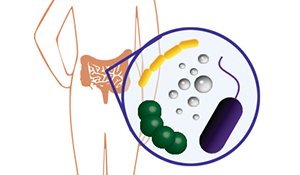Got gas? Blame it on your bacteria
September 2016.
By Prof. Robert Hutkins, PhD –
When I tell friends and family that I study gut bacteria and gut health, the most frequent question I am asked is why some foods cause intestinal gas. The next question is almost always whether or not gas is such a bad thing.
Bloating, constipation, indigestion, and yes, intestinal gas, are among the most common health complaints among the general population. Indeed, one of the main reasons for a person to see a gastroenterologist is due to excessive “passing of gas”.
According to the actual research, most healthy people have about 10 to 20 discharges per day. In terms of volume, this represents about a liter of gas (about a quart’s worth). And yes, some poor graduate student probably had to somehow measure this.
In general, intestinal gas or flatulence is only a problem in social circumstances, like business meetings, religious events, classrooms, or elevators. Apart from the sound effects and associated aroma, gas is usually not a serious condition. At minimum it is usually only annoying or embarrassing. When it’s more severe, however, excessive gas can have considerable impact on quality of life. It may also be a symptom of a chronic condition, like Irritable Bowel Syndrome (IBS) or celiac disease, for which a physician should be seen.
Although there are many causes for intestinal gas, diet is certainly near the top of the list. The notion that there are gas-generating foods has become part of our popular culture. On the American Gastroenterological Association list of such foods are milk (for lactose maldigestors only) and high-fiber grains, like whole wheat, oatmeal and oat bran. Sweeteners like fructose and sorbitol can also be gas-producing.
Unfortunately, many of the healthy foods we are encouraged to eat, including broccoli, cauliflower, cabbage, Brussel sprouts, and other cruciferous vegetables are known to cause gas. Likewise for onions, leeks, garlic, figs, and prunes. However, it’s the beans, lentils, and other legumes that are perhaps the most infamous gas-causing foods (thanks, in part, to the campfire scene in Blazing Saddles).
Ultimately, there are two main reasons for intestinal gas. One is simply swallowed air. Some, but not all, of this air is expelled via burps.
The other source of gas, and the main reason why foods are implicated, is (micro)biological. Specifically, the foods mentioned above (beans, bran, and broccoli) all contain carbohydrates that resist digestion in the stomach and small intestine and make their way to the colon. Upon arrival, they become food for the trillions of bacteria that reside there. These bacteria ferment these carbohydrates and produce gases, mainly hydrogen, carbon dioxide, and methane. Some gases are absorbed, some are expelled via breathing, and some are recycled by other bacteria. But the gas that remains – well, it’s got to go somewhere, and that somewhere is you know where.
It’s important to note that many of these gas-producing bacteria that feed on dietary fibers are often the same species that contribute to intestinal health. That’s one reason why a little gas can be good, even smelly gases like hydrogen sulfide. It tells you the bacteria in your gut are doing their job. Indeed, there is a new category of food ingredients called prebiotics that are now being added to yogurt, kefir, crackers, and other foods for the purpose of nourishing gut bacteria.
For people already struggling to get more whole grains, beans, vegetables, and fiber into their diet, intestinal gas can be quite unwelcome. However, researchers have shown that patience is a virtue. Consumers who increase their fiber consumption may experience gassiness, but they will often return to normal after a week or two. Gradual increases are often easier to manage. Finally, there is emerging evidence that some probiotic bacteria can reduce the frequency and volume of gas.
Prof. Robert Hutkins, PhD
Khem Shahani Professor of Food Science
University of Nebraska, Lincoln
Webpage







